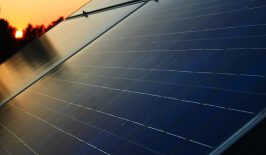The UN’s Sustainable Development Goals call for “access to affordable, reliable, sustainable and modern energy for all”. And yet, although the global electrification rate has risen by six percentage points to 89 percent in the last seven years, around 840 million people around the world still have no reliable access to electricity.
In sub-Saharan Africa in particular, many people are not connected to the electricity grid. There, the electrification rate is only 44.6 percent, with huge disparity in access between different countries. In the East African country of Burundi, for example, only 9.3 percent of people have access to the electricity grid, whereas in Gabon, it’s 92 percent. And there is a huge contrast between the urban and rural populations too. In rural areas of sub-Saharan Africa, the electrification rate is significantly lower than in the cities. And setting up an electricity grid in rural areas is often very costly, particularly in the global South. While rough and impassable terrain, in addition to financial, regulatory and technical challenges, all pose a challenge too. In many areas, off-grid solutions such as roof top solar systems, to power lights and water pumps, are usually the better alternative – at least for people who can afford it. Where it isn’t available, people resort to traditional, CO2-intensive energy sources such as firewood, kerosene lamps or even diesel generators.
So-called “mini-grids” offer an alternative. Mini-grids are a series of electricity generation and storage systems that are connected to each other and also to a distribution network. This network, which is independent of the national electricity grid, supplies local customers with anywhere between ten kW and ten MW of power. The energy source can be a diesel generator, renewable energies or a mixture of both. An estimated 47 million people are connected to about 19,000 mini-grids throughout the world. Set up and managed by public or private utility companies – or sometimes the communities themselves – mini-grids provide households, public institutions and companies with access to a decentralised power supply.
In recent years, more and more mini-grids have been created worldwide. This is partly due to the falling costs of renewable energy technologies – solar modules in particular – but also due to the digital innovation boom in countries in sub-Saharan Africa. Against the background of these developments, a study by the IASS Potsdam (Institute for Transformative Sustainability Research) has taken a look at how digital tech could be applied to mini-grids in order to help them shift from fossil fuels and use more renewable energies instead, and to ensure a democratic, affordable and reliable power supply.
They looked at two different areas where digital technologies could be applied:
- technical functionality and system balancing: this includes generation and storage, distribution and control, and demand-side management.
- the value chain of mini-grids: this includes the financing, planning and design, operation and maintenance, customer management and the productive use of electricity
For example, when it comes to energy production and storage, digital tech could be used to make mini-grids “smarter”. Weather forecasting algorithms (that let systems know when the sun will shine and solar power is there for the taking) could help optimise hybrid networks that generate electricity from a combination of solar panels and diesel generators. This would help make power generation cleaner, and less dependent on conventional, CO2-producing diesel generators.
Digital technologies can also be useful when it comes to addressing the problem of financing. As an example, the study mentions that various crowd financing campaigns have been carried out online platforms to help cover the high investment costs required to set up mini-grids. They point out, however, that although they can help cover these kind of up-front costs, not much is yet known about how mini-grids will deal with any financial problems later on, like when customers can’t pay for their electricity. Another approach to financing goes hand in hand with the application of blockchain technology, like for example the SolarCoin project. However, there are still very few solutions of this type, and they’re still in the early stages.
Satellite Data, Image Recognition and Drones for Planning Mini-Grids
During the planning phase of mini-grids, satellite data, digital maps and image recognition can be used to identify locations suitable for electrification. Drones can take pictures of a potential areas from above, for example, which makes it easier to pick the ideal location. Digital technologies can also help address another issue that mini-grids regularly face – maintenance. Remote monitoring systems, which are often cloud-based, allow the systems to be checked in real time, e.g. for battery status and performance. And when it comes to so-called “predictive maintenance”, algorithms can help anticipate faults and notify service personnel so that they can perform maintenance tasks when necessary. This also helps them better plan their long and difficult journeys out to the rural areas where the grids are located.
For operators, customer payments are another important aspect that can be simplified by the use of digital technologies. Customers can pay for their electricity with mobile money, such as M-Pesa in Kenya, for example. Apps could also help provide more detailed information about their payments, system status and energy consumption behavior – but this only works in areas with good network coverage and is therefore not yet fully operational in many parts of sub-Saharan Africa.
According to the authors of the study, the use of digital technologies in mini-grids in rural Africa also poses new challenges and risks – especially when it comes to privacy and data security. However, the general conclusion is clear – digital technologies, when used carefully and correctly – can play a crucial role in sustainable development, in reducin energy poverty, and in the rise of renewables in the Global South.
This is a translation by Mark Newton of the original article which first appeared on RESET’s German-language site.






